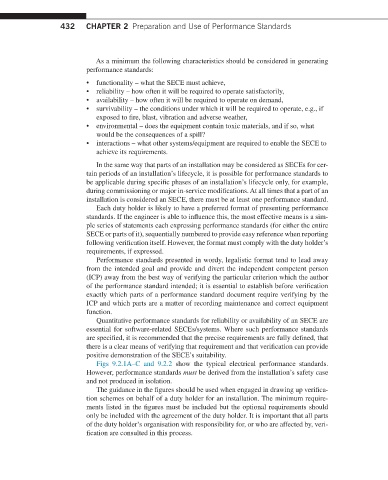Page 445 - Offshore Electrical Engineering Manual
P. 445
432 CHAPTER 2 Preparation and Use of Performance Standards
As a minimum the following characteristics should be considered in generating
performance standards:
• functionality – what the SECE must achieve,
• reliability – how often it will be required to operate satisfactorily,
• availability – how often it will be required to operate on demand,
• survivability – the conditions under which it will be required to operate, e.g., if
exposed to fire, blast, vibration and adverse weather,
• environmental – does the equipment contain toxic materials, and if so, what
would be the consequences of a spill?
• interactions – what other systems/equipment are required to enable the SECE to
achieve its requirements.
In the same way that parts of an installation may be considered as SECEs for cer-
tain periods of an installation’s lifecycle, it is possible for performance standards to
be applicable during specific phases of an installation’s lifecycle only, for example,
during commissioning or major in-service modifications. At all times that a part of an
installation is considered an SECE, there must be at least one performance standard.
Each duty holder is likely to have a preferred format of presenting performance
standards. If the engineer is able to influence this, the most effective means is a sim-
ple series of statements each expressing performance standards (for either the entire
SECE or parts of it), sequentially numbered to provide easy reference when reporting
following verification itself. However, the format must comply with the duty holder’s
requirements, if expressed.
Performance standards presented in wordy, legalistic format tend to lead away
from the intended goal and provide and divert the independent competent person
(ICP) away from the best way of verifying the particular criterion which the author
of the performance standard intended; it is essential to establish before verification
exactly which parts of a performance standard document require verifying by the
ICP and which parts are a matter of recording maintenance and correct equipment
function.
Quantitative performance standards for reliability or availability of an SECE are
essential for software-related SECEs/systems. Where such performance standards
are specified, it is recommended that the precise requirements are fully defined, that
there is a clear means of verifying that requirement and that verification can provide
positive demonstration of the SECE’s suitability.
Figs 9.2.1A–C and 9.2.2 show the typical electrical performance standards.
However, performance standards must be derived from the installation’s safety case
and not produced in isolation.
The guidance in the figures should be used when engaged in drawing up verifica-
tion schemes on behalf of a duty holder for an installation. The minimum require-
ments listed in the figures must be included but the optional requirements should
only be included with the agreement of the duty holder. It is important that all parts
of the duty holder’s organisation with responsibility for, or who are affected by, veri-
fication are consulted in this process.

